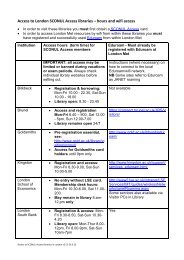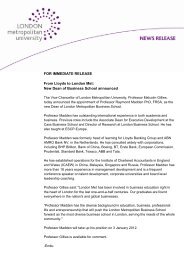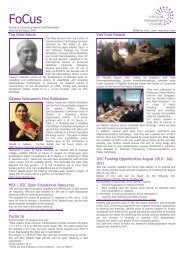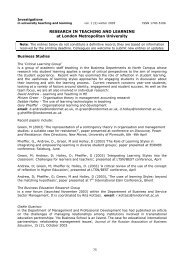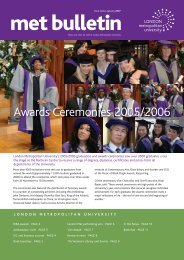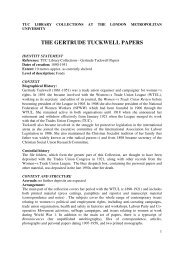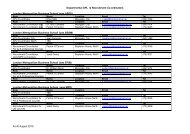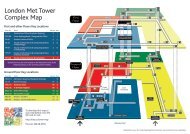Researching citizenship: - London Metropolitan University
Researching citizenship: - London Metropolitan University
Researching citizenship: - London Metropolitan University
Create successful ePaper yourself
Turn your PDF publications into a flip-book with our unique Google optimized e-Paper software.
This Guide has been written and prepared by the CiCe Network’s Working Group on<br />
Practice-Based Research:<br />
Richard Etienne is a researcher and professor at the university Montpellier III (France).<br />
He studies procedures of change in education and teacher training. He works on special<br />
needs in education and on project management in schools. As the head of education<br />
department in France he had to set up a branch of training in special needs education<br />
Hugo Verkest is both a lecturer at the School of Education (normaalschool) on the<br />
Torhout (Belgium) Campus of the Katholieke Hogeschool Zuid- West- Vlaanderen (KATHO -<br />
RENO) and senior lecturer in methodology in the Higher Episcopal Institute of Education<br />
(HIVO- Brugge). He gives courses and workshops for students and teachers about<br />
evaluation and visual data concerning poverty in relation to <strong>citizenship</strong>. He’s engaged as a<br />
volunteer in projects about art, rural identity, refugees and equal opportunities and is the<br />
international co-ordinator of KATHO– RENO (for primary education).<br />
Luisa Freitas is Associate Professor of Social Studies Education at the Institute of Child<br />
Studies at the <strong>University</strong> of Minho (Portugal). She teaches initial and in-service courses in<br />
elementary and childhood teacher education. Her research interests focus on how children<br />
develop time and space concepts, as well as identity and <strong>citizenship</strong> in the context of social<br />
studies classrooms in primary schools through several strategies, specifically cooperative<br />
learning.<br />
Marcel Mečiar is a researcher and lecturer at the <strong>University</strong> of Ostrava (Czech Republic).<br />
He is interested in the study of social identities (regional identity, identity of immigrants,<br />
pupils’ identities). On the pedagogical field, he works as a member of the Department of<br />
Social Sciences at the Pedagogical Faculty on “a translation” of scientific knowledge<br />
concentrating on the form that would be useful for teachers of Civic Education on the level<br />
of elementary schools<br />
Series editor: Alistair Ross, International Coordinator, CiCe<br />
This report does not necessarily represent the views of the CiCe Network.<br />
This project has been funded with support from the European<br />
Commission. This publication reflects the views only of the<br />
authors, and the Commission cannot be held responsible for<br />
any use which may be made of the information contained<br />
herein.<br />
CiCe Guides for Research Students and Supervisors:<br />
<strong>Researching</strong> Citizenship – what has been done, what is to be done?<br />
ISBN: 1 899764 74 7<br />
CiCe Guidelines: ISSN 1741-6353<br />
September 2006<br />
CiCe Central Coordination Unit<br />
Institute for Policy Studies in Education<br />
<strong>London</strong> <strong>Metropolitan</strong> <strong>University</strong><br />
166 – 220 Holloway Road<br />
<strong>London</strong> N7 8DB<br />
UK<br />
This publication is also available in electronic format at http://cice.londonmet.ac.uk
CiCe guides for practice-based research<br />
Developing practice-based research for<br />
co-operation and co-operative learning<br />
Richard Etienne, Hugo Verkest,<br />
Luisa Freitas and Marcel Mečiar
Developing Practice-Based Research 1<br />
Contents<br />
1. Introduction<br />
2. Is practice-based-research really research – or is it just<br />
systematic enquiry?<br />
3. Team meetings about co-operative learning and practitioner<br />
based research<br />
4. Co-operative learning in a lesson<br />
• The basic elements of co-operation<br />
• Is the teacher important and necessary in co-operative<br />
learning?<br />
• The role of a teacher<br />
• Elicitation and promotion of a climate of cooperation in<br />
education<br />
• Classroom environment and cooperation<br />
5. A cooperative class council in an urban single class<br />
• A single … and singular urban class council<br />
• The construction of the law like local common good<br />
6. The visual and spatial dimension of co-operation in school!<br />
• Freinet, the architect of co-operation?<br />
• School building from ghetto to oasis<br />
• Symbolising co-operation at school<br />
7. Conclusions<br />
8. Appendix<br />
9. References<br />
1. Introduction<br />
These guidelines focus on supporting the development of<br />
practice-based research for students in their 1 st or 2 nd cycle of<br />
study, or on CPD 1 courses, that refer to professional practice.<br />
The topic of this booklet is how we connect co-operative<br />
learning and co-operation with practice-based research.<br />
The appendix gives a set of ‘open’ sentences and eyeopeners.<br />
In the CiCe conference in Riga (2006) the authors<br />
organised a workshop, which outlined the results and framed<br />
these with references to other practice-based research. The<br />
workshop was supported by video clips and power point<br />
presentations. We hope to present an edited CD with this<br />
material with our next set of guidelines.<br />
1 CPD courses: Continuing Professional Development Courses.
2 Developing Practice-Based Research<br />
2. Is practice-based-research really research or is it just systematic<br />
enquiry?<br />
We begin with a broad discussion around several<br />
perspectives. Perhaps the most widespread discussion relates<br />
to action-research, though several general texts on research<br />
continue to ignore this field. Practice-based research, or<br />
practitioner-based research, is even less commonly found in<br />
general research methodologies books. Even John Elliot, a<br />
founder member (with Lawrence Stenhouse) of the Centre for<br />
Curriculum Development and Research (CARE) 2 uses the term<br />
practice-based research rather than action research.<br />
Elliot (2004) identifies five aspects that characterize CARE’s<br />
conception of Applied and Practice-based Research, of which<br />
the fifth aspect is applied research which is<br />
is ‘practice-based’ (this includes ‘policy-making’) and<br />
therefore engages practitioners 3 /policymakers in the<br />
research process … Practice-based research in the<br />
context of CARE’s message about Applied Research<br />
takes the form of a democratic and conversational<br />
construction of actionable knowledge that is<br />
disciplined by evidence.<br />
The highlighted words stress that practice-based research is<br />
developed by practitioners, but should be based on evidence.<br />
For Elliot it is not possible to carry practice-based research in<br />
isolation: it should be collaborative and he stresses that<br />
academic researchers<br />
have a special role to play as facilitators in this<br />
process, inasmuch as they are capable of providing<br />
practical and theoretical expertise on the<br />
methodologies that can be deployed for constructing<br />
‘knowledge in the context of action’ (or at least in a<br />
good position to access it).<br />
We think that stressing the idea of evidence based is a way to<br />
reinforce the idea of strong academic research.<br />
In a response to an issue of Educational Researcher on<br />
Research for Doctoral Students in Education 4 , Anderson<br />
(2002) argues that practitioner-based inquiry has many<br />
features that push it towards the field of true research. He<br />
suggested that the two main reasons for the lack of academic<br />
attention to practitioner researcher were: “the perception of<br />
a lack of guidelines for both the quality of and a formalized<br />
methodology for such research, and … the lower academic<br />
2<br />
CARE related to the <strong>University</strong> of East Anglia is being, since 1970, one of the research<br />
centers that assumed a most important role in practice-based research, not only in the<br />
field of education, but also on Medical and Health, one of most developed fields of practicebased<br />
research.<br />
3<br />
The emphasis is ours.<br />
4<br />
Educational Researcher 30(5), 2001
Developing Practice-Based Research 3<br />
status attached to it” (Anderson, 2002, p. 22-23). The third<br />
reason is about purpose: although practitioner-based research<br />
shares the goal of knowledge production, it also has other<br />
goals, which may sometimes be excessively emphasized.<br />
Anderson defends practitioner researchers as knowing the<br />
field better than the ethnographic researcher: their<br />
“knowledge is deeper, more nuanced, and more visceral. Of<br />
course these characteristics make this knowledge not only<br />
more powerful but also more in need of researcher reflexivity<br />
and triangulation with other data sources” (p. 23). In relation<br />
to the status, he argues that not only do “educational<br />
researchers belong to a community of practice” but also that<br />
they “might constitute a community of researchers” (p. 24).<br />
On the purpose of practitioner-based research, he stresses<br />
that the ultimate purpose of research is not knowledge itself,<br />
but the transformation of practice.<br />
This idea that practitioners-researchers are more reflexive<br />
than other researchers recalls Schön’s special role for the<br />
development of reflection among educators and other<br />
professionals; reflection in practice and reflection on reflection<br />
in practice. A reflective teacher would have been prepared to<br />
develop practice-based research. In his AERA presentation,<br />
Schön (1987) ended with the hope that the promotion of<br />
reflective practitioners would be a first step “to create a new<br />
kind of research presence, who want to produce experiences<br />
and knowledge which is usable by teachers” - the kind of<br />
research that would effectively “healing the splits between<br />
teaching and doing, school and life, research and practice,<br />
which have been so insidiously effective at deadening the<br />
experience of school at all levels.”
4 Developing Practice-Based Research<br />
3. Team Meetings about Co-operative Learning and Practitioner Based<br />
Research<br />
This section is based on observations in pre-school and<br />
primary school (3rd grade classroom and a kindergarten for 3<br />
to 6 years olds). These classroom teacher interviews 5 show<br />
the importance of collaboration between school staff and<br />
parents, and the significance of this for co-operative learning<br />
and practice-based research.<br />
The three kindergarten teachers placed great importance on<br />
their regular daily meetings with the pedagogical director,<br />
their monthly faculty and technician meetings, their monthly<br />
meetings with the parents association, and their perceptions<br />
of the importance of a culture of collaboration growing in their<br />
institution. This led us to consider these meeting in more<br />
depth. The teachers use co-operative learning in their<br />
classrooms, despite the constrains with very young children:<br />
Caroline - During planning time ... two children were certain<br />
they wanted to go to the construction area to make a train<br />
with the child who already had chosen to do this, but when<br />
there, they all constructed their own training in isolation.<br />
Our classroom observation, visits and interviews of these<br />
three teachers showed how they were developing a culture of<br />
collaboration. According to Johnson and Johnson (1994) this<br />
is the most essential factor to promote successful cooperative<br />
learning implementation in classrooms: they<br />
presented a scheme showing several co-operative groups in a<br />
Co-operative School Organizational Structure: the School<br />
board; Superintendent and Staff; Principal Collegiate Groups;<br />
Teacher Collegiality Groups and Co-operative Learning Groups<br />
(1994, p. 61). The Co-operative School Organizational<br />
Structure could be represented as follows:<br />
School President and Staff<br />
(teachers and technicians) –<br />
meetings - one time a month<br />
5 Teachers names are pseudonyms<br />
School President and Eight Directors<br />
Parents Council - 20 parents and 3<br />
teachers as invited<br />
observers<br />
meetings - one time<br />
a month<br />
18 teachers, 1 Pedagogical Director and the President<br />
Meetings - each day from 16:30 to 17:30<br />
Cooperative Learning groups – children in their classrooms
Developing Practice-Based Research 5<br />
Teresa, the first to start teaching in the school, recalled the<br />
differences from when she started, alone in her classroom.<br />
There are now teachers meetings, a supportive president and<br />
a pedagogical director. She and her colleagues have two<br />
teacher aides in their classrooms. The integration of these<br />
staff into the cooperative school structure seemed to us the<br />
less well integrated. Teresa observed: Sometimes it is<br />
frustrating when we want children to some conclusions by<br />
themselves, and a teacher aide gives the answer, or when<br />
she draws for the special needs child. Richard said that<br />
sometimes, when he thinks that teacher aides may be going<br />
to answer, he says: No one answers without raising their<br />
hand!<br />
Teacher assistants do not participate in any of the meetings<br />
listed. Our analysis of the interview suggested that this would<br />
be different if there were meetings of teachers and teacher’<br />
aides. Caroline, Richard and Teresa valued their collaboration:<br />
they are much more experienced, and in some areas much<br />
more knowledgeable … they do many things … for example,<br />
Rita is an extraordinary source of ideas for visual art, she<br />
solves technical problems with several kinds of paintings and<br />
drawings.<br />
Schmuck (1998) developed the concept of Organizational<br />
Development associated with Co-operative Learning.<br />
Organizational development<br />
aims at helping school participants to manage their<br />
school collaboratively and effectively. It focuses on<br />
improving the participants’ communication and<br />
meeting skills on their learning together to carry out<br />
co-operative goal setting, problem solving, action<br />
planning, decision making, and assessment of<br />
outcomes. (p. 244).<br />
Daily teacher meetings are central in school change, though<br />
the three teachers also stressed the president’s support in<br />
this. Support in the school direction is for many<br />
commentators a central factor in any school innovation. The<br />
administration of key actors not only promotes organizational<br />
development, but also co-operative learning. The relationship<br />
between these is two way and reciprocal, and they have some<br />
similar goals:<br />
Organizational Development Co-operative Learning<br />
1. To increase understanding<br />
of how staff members with<br />
different jobs interrelate and<br />
effect one and other.<br />
2. To develop clear<br />
communication networks up,<br />
down, and laterally.<br />
To increase empathy and<br />
understanding among students<br />
with different personal<br />
characteristics.<br />
To establish clear<br />
communication among all<br />
classroom members.
6 Developing Practice-Based Research<br />
3. To increase understanding<br />
of different educational goals<br />
in different parts of the<br />
educational system.<br />
4. To uncover organizational<br />
conflicts for constructive<br />
problem-solving.<br />
To help students understand<br />
the different values and<br />
attitudes that exist in their own<br />
peer group.<br />
To assist students in dealing<br />
with conflicts and in converting<br />
frustration into problem solving.<br />
(Schmuck, 1998, p. 252)<br />
Many ideas about organizational development and/or<br />
professional development have a close relationship with<br />
practice based-research. To develop practice-based research<br />
it is necessary to promote professional development, but to<br />
do practice-based research contributes to professional<br />
development. A good initial education in developing practicebased<br />
research would be an important preparation for<br />
teachers to implement co-operative learning and vice-versa.<br />
Sharan and Sharan (1992), the authors of the co-operative<br />
method known as Group Investigation, advocate a model for<br />
preparing teachers based on the two principles of ‘Experience<br />
and Reflection’ and ‘Conceptualizing and Planning’.<br />
The experiential learning model also develops the teacher’s<br />
conceptual framework and lends order to his or her<br />
observations and reflections about their experience. When<br />
teachers summarize what they have learned from carrying<br />
out the stages of Group Investigation, the general principles<br />
about the structure and process of this method serve as a<br />
basis for implementing Group Investigation in their classroom.<br />
(Sharan and Sharan, 1992, p 155).<br />
Our experience of mentoring practitioner-based research with<br />
undergraduate students, and with postgraduate student<br />
teachers, shows that the experience of Group Investigation is<br />
a good start to understand the principles of practice-based<br />
research. Practice-based research is similar to Group<br />
Investigation learning. Students with deadlines and grades<br />
would be less stressed if they have some previous practical<br />
preparation. Our experience tutoring students developing<br />
practice-based research also suggests that previous<br />
experiences are more helpful than attending general<br />
methodology courses.<br />
The three interviewees confirm this: Caroline said - Our<br />
meetings are very good for us, we reflect on our experience,<br />
what worked well, what didn’t; we also listen to other<br />
colleagues reflecting on their experiences. Then, based on<br />
this, we plan our projects and in this way improve them.
Developing Practice-Based Research 7<br />
Without consciously having any theoretical model as guide 6 ,<br />
our interviewees’ conversations showed several steps in a<br />
theoretical model of creating a community context for cooperative<br />
learning. Graves (1994) stresses that such a<br />
community is a more secure and inspiring work environment<br />
for teachers and students, and that it encourages new<br />
teaching/learning strategies and empower teachers to run<br />
faculty meetings more efficiently and actively. Graves<br />
suggests how to develop this slow development process<br />
through several steps, for each of which she presents a<br />
question. We could identify these steps in the construction of<br />
a co-operative community in our observations of Caroline,<br />
Richard and Teresa’s school.<br />
Teresa’s initial experiences were of coming to school and the<br />
classroom without speaking to anyone. While she talked with<br />
colleagues in break times, this has now changed: they still<br />
talk, but - How different our group dynamics are now! They<br />
also meet with speech therapists, nurses and parents – not<br />
just individual parents, but also with a body with influence.<br />
Teresa experienced the first step of co-operative community<br />
building - where the question was: Who are we?<br />
Starting to use unifying schools rituals began thinking about<br />
developing common projects. Caroline and Richard entered in<br />
this phase, when they were thinking about more interesting<br />
projects. Richard recalled - Do you remember when Caroline’s<br />
idea was so well accepted by all of us? This second phase is<br />
characterised by the question What can we do together? The<br />
three teachers, one by one, listed the projects developed as a<br />
school that started in a classroom.<br />
We do not notice problems in the third phase, when the<br />
question is: How can we do our best? Sometimes there is a<br />
sense of frustration because the tasks are more complex and<br />
demanding and some conflicts are more evident. This<br />
moments was shown in the school when they started the<br />
project Collaborating with families 7 . This was when the<br />
Parents Council was created, a very important moment.<br />
The fourth phase gave much satisfaction; the question is How<br />
can we help others? The group organise events to show to<br />
other institutions their projects, and encourage them to share<br />
their experiences. This kind of community does not end, but<br />
is continually modified. They have not reached the last phase<br />
when the question is How to say goodbye? However, Teresa<br />
6 The three followed a program in their initial teacher training education or in GPD courses<br />
that were truly concerned to teachers’ professional development and that included practice<br />
based research and some other colleagues also had a similar education.<br />
7 Most families were and continue to be from middle class and only the last years the<br />
school, that already maintain the name crèche, is a school with more middle class parents,<br />
in spite of only who, for some reason, know well the institution have a good idea about its<br />
excellence.
8 Developing Practice-Based Research<br />
stresses that the group dynamic is the reason why no one has<br />
moved to another institution. But they are not a closed group,<br />
because each year new teachers come to the nurse classes,<br />
now they do not have only teacher’s aids but they already<br />
have an early education teacher for all groups, which was one<br />
of our fights, dreams.<br />
From our interviews, we would draw attention to just one<br />
more comment from Richard. He spoke less, maybe because<br />
it was only he who attended our course. When the other<br />
spoke of the importance of having a supportive group and a<br />
President who paid attention to new ideas to improve school,<br />
he exclaimed - How could a teacher in a village in a region<br />
like Guarda 8 , with just a dozen children, develop projects like<br />
we do, or carry out any kind of research?<br />
Collaboration is necessary in developing practitioner–based<br />
research it - not only between the tutor, the higher education<br />
faculty and the practitioner-researcher - but with others that<br />
have an interest in it.<br />
8 An interior area in the less developed Portuguese region.
Developing Practice-Based Research 9<br />
4. Co-operative learning in a lesson<br />
There are three basic ways students can interact<br />
with each other as they learn. They can compete to<br />
see who is "best"; they can work individualistically<br />
on their own toward a goal without paying attention<br />
to other students; or they can work co-operatively<br />
with a vested interest in each other's learning as well<br />
as their own. (Johnson & Johnson 1988: 34)<br />
Co-operative learning is a group-based approach. This type of<br />
learning differs from individual learning, in that it is based on<br />
cooperation in solving complicated tasks. Pupils are led to<br />
share social roles, plan the whole activity, divide tasks, solve<br />
particular conflicts, join particular outcomes to a complex<br />
whole, and evaluate the benefits to participants. Most school<br />
work is done in groups, but cooperative learning does not just<br />
involve students performing some task in a group: they have<br />
to facilitate each other's learning in the task, and this often<br />
requires help from the curriculum designer and instructor.<br />
Co-operative learning has been defined as "small groups of<br />
learners working together as a team to solve a problem,<br />
complete a task, or accomplish a common goal" (Artz &<br />
Newman 1990: 448). According to Slavin, "co-operative<br />
learning refers to classroom techniques in which students<br />
work on learning activities in small groups and receive<br />
rewards or recognition based on their group's performance"<br />
(Slavin 1983: 332). Johnson, Johnson, Holubec (1993: 9)<br />
define it as "the instructional use of small groups, so that<br />
students work together to maximize their own and each<br />
other's learning".<br />
First, it is necessary to emphasise that many teachers do not<br />
understand the essence of co-operative learning. Cooperative<br />
learning does not mean that:<br />
• Students sit side by side at the same table and talk with<br />
each other as they do their individual assignments.<br />
• Students do a task individually, with the instruction that<br />
those who finish first are to help the slower students.<br />
• Assigning a report to a group where one student does all<br />
the work and others put their name on it.<br />
Johnson and Johnson argue that co-operation is much more<br />
than being physically near other students, discussing material<br />
with other students, helping other students, or sharing<br />
materials with other students, although each of these is<br />
important in co-operative learning.
10 Developing Practice-Based Research<br />
4.1 The basic elements of cooperation<br />
In order for a lesson to be co-operative, five basic elements<br />
are essential (Johnson & Johnson, 1989; Johnson, Johnson, &<br />
Holubec, 1993). These are:<br />
Interdependence: Since the students are helping each other<br />
learn, they must work together to learn well. If all do not<br />
contribute, the group members will not learn as much: to<br />
promote interdependence, students need to be able to<br />
make unique contributions to the group, possibly by<br />
being divided into different roles or by being assigned<br />
different parts of the task.<br />
Interaction: Students cannot learn together in isolation.<br />
They should meet face-to-face or on-line, to review the<br />
overall task and their particular pieces of it so that<br />
everyone understands what is expected of them.<br />
Sometimes, the task (or part of it) can be done<br />
separately, but even then students should ask each other<br />
questions and find resources for one another. The task<br />
often requires team members to work together. Before<br />
completing the final project, students need to review<br />
each other's work and suggest revisions. This step is<br />
often skipped, resulting in a poorer project, with less<br />
good grades - and hard feelings within the group.<br />
Individual Accountability: Since the goal of co-operative<br />
learning is enhanced individual learning, it is possible to<br />
assess students individually. Assigning part of the grade<br />
on the group projects promotes interdependence, but the<br />
instructor must reserve part for individual assessment, to<br />
prevent hitchhiking (one student failing to do their fair<br />
share, damaging his or her team-mates’ learning and<br />
grades).<br />
Interpersonal Skills: Effective teamwork requires<br />
motivation, communication skills, and assessment skills.<br />
Students may come in to the class without good smallgroup<br />
skills and will need to develop them. For this<br />
reason, later group projects will probably run more<br />
smoothly and efficiently than early ones as students<br />
develop their skills.<br />
Group Processing: The group assesses at least some of its<br />
work together with an eye to improving it or towards<br />
doing even better on the next project (this includes the<br />
review of work before turning it in).
Developing Practice-Based Research 11<br />
4.2 Is the teacher's role important and needed in the cooperative<br />
learning process?<br />
Most descriptions of cooperative learning deal with students<br />
and their assessment during a lesson: fewer authors<br />
concentrate on the role of the teacher. We asked professional<br />
teachers and academics in a workshop on co-operation (in<br />
Riga, May 2006) what they thought of cooperation and the<br />
role of the teacher in cooperative learning. Is she/he needed<br />
in it? What should she/he do and what not to do?<br />
The main points raised are in the following section. How did<br />
we elicit these reactions from our colleagues? The workshop<br />
was divided into four parts (intended to be four corners, but<br />
the shape of our room did not allow this). Each part was<br />
moderated by a team-member, and visually accompanied by<br />
a video or picture presentation prepared for the workshop.<br />
The records consisted of real-life situations in a school (a<br />
class council, a staff session, a lesson, a space).<br />
4.3 The role of the teacher<br />
The role of the teacher in a co-operative learning process is to<br />
be a person in whom pupils trust. He/she must be able to<br />
present and explain the difference in this learning approach,<br />
compared to ‘classic’ competitive and individual approaches,<br />
to give a clear plan and quietly control the process. The<br />
authority of teacher and the pupils' confidence is assumed in<br />
using this method: without these, the lesson can disintegrate<br />
and the aims will not be achieved.<br />
The hardest task for a teacher is to prepare the class for<br />
cooperative learning. The idea that one ‘just jumps on the<br />
cooperative learning train’ is too optimistic. Preparation is<br />
important, essential and necessary, the extent depending on<br />
how much the pupils are used (or not) to team-work,<br />
delegating roles and so on. There are differences between<br />
educational systems, schools, and teachers. The obligation of<br />
the teacher is to create the conditions for passing on<br />
knowledge so that a pupil understands a sense of things and<br />
looks for links and a sense of coherence.<br />
Teachers using co-operative learning in their classroom play<br />
multiple roles. The teacher's repertoire in co-operative<br />
learning includes:<br />
• explicit instruction on how to behave (see Jacobs' norms<br />
in the next paragraph),<br />
• modelling – the teacher must be a role model and must<br />
practise what he/she teaches - which means cooperating<br />
with others in the class!,<br />
• feedback - the teacher makes clear what is expected of<br />
students as they work, both individual and group
12 Developing Practice-Based Research<br />
feedback is expected, with a focus on what is working<br />
well and on what needs improving,<br />
• intervention – for example, if noise level disrupts others,<br />
or there is persistent off-task behaviour by pupils,<br />
• strategic task selection – the teacher has to plan<br />
worthwhile, rich tasks for students to co-operatively<br />
engage in.<br />
4. 4 Promotion - building a climate of co-operation<br />
Classroom atmosphere forms a key ingredient in the<br />
success of co-operative learning (Jacobs 2002: 5).<br />
To create a co-operative atmosphere, class building activities<br />
can be used. Class building is working to build a feeling of<br />
trust and solidarity among all the members of the class, which<br />
is crucial for the success of co-operative learning. To an<br />
extent it is similar to the contract that (according to<br />
approaches of some pedagogical traditions) used to be<br />
concluded between pupils and teacher, and between pupils.<br />
George Jacobs (2002: 5) suggests sticking up several norms<br />
so that everyone can see them on the wall:<br />
• I listen when others talk.<br />
• I encourage everyone to participate.<br />
• I help others without doing the work for them.<br />
• I ask for help when I need it.<br />
• I am critical of ideas, not people.<br />
• I remember that we are all in this together.<br />
• I value and respect each person as an individual, as<br />
a group mate, and as part of our class regardless of<br />
race, religion, nationality, or academic performance.<br />
We call these norms rather than rules because norms<br />
flow from shared values, such as the value of<br />
cooperation.<br />
Students need to understand that:<br />
• Co-operative learning benefits us in many ways, both at<br />
school and in life outside school.<br />
• Effective co-operation takes work. Teams can work<br />
effectively or ineffectively. There are ways of recognising<br />
an effective team.<br />
• We can influence the success of our team by the way we<br />
behave as individuals.<br />
• Everyone can learn to improve their capacity to cooperate<br />
with others.<br />
(Murdoch & Wilson 2004: 14)
Developing Practice-Based Research 13<br />
4.5 Classroom environment and co-operation<br />
The proper arrangement of the classroom is another<br />
important way to effect co-operation. The creation of a<br />
constructive classroom environment – reflected both in the<br />
physical facilities and in the general organization of activities<br />
– depends on the teacher’s tactful and judicious management<br />
of resources and constraints, to be a helpful leader but not an<br />
authoritarian oppressor, and thus provide a context in which<br />
pupils will be free to learn and develop vigorously.<br />
Freinet (1896-1966), a reformer who promoted co-operative<br />
learning (see section 6, below), proposed detailed leadership<br />
rights and duties that effective teachers must assume. The<br />
teacher will be promoted to the dignity of a new role,<br />
involving:<br />
• constantly improving – individually and cooperatively,<br />
and in collaboration with the pupils – the<br />
material organization and the community life of the<br />
school;<br />
• letting all pupils engage in work and play that meets<br />
their inclinations and vital needs as much as<br />
possible;<br />
• eventually directing and efficiently helping workers<br />
who are having trouble, with neither bad temper nor<br />
useless scolding;<br />
• finally, assuring the constant reign of all-powerful<br />
and harmonious work at school. (1993:415-6)<br />
Students should sit close together to share materials more<br />
easily, and to use quiet voices that can't be heard by other<br />
groups. On the other hand, they need to have enough room<br />
for a free movement. Seating arrangements foster cooperation,<br />
so a group will function well or not just by the way<br />
they sit (e. g. somebody in a corner unable to reach the<br />
materials, or out of the inner circle). Real problems can be<br />
caused by a shape of a room (narrow and long) or with<br />
furniture fastened to the floor for frontal teaching, that can't<br />
be moved for co-operative learning. Jacobs (2002) concludes<br />
that the teacher also needs space to circulate round the room<br />
to visit all the groups.
14 Developing Practice-Based Research<br />
5 Co-operative class council in an urban single class<br />
In school systems in southern Europe traditional transmission<br />
is based on professorship: pupils use the skills of listening,<br />
understanding and transforming professorial speech into<br />
knowledge which must be related to an academic task (to<br />
write an essay, to solve a problem, etc). Freinet (1950)<br />
contributed to a new view of education through a natural<br />
method based on the activity of pupils and their cooperation.<br />
Regular meetings with the whole school – or with parts of itcan<br />
stimulate staff and student awareness of whole school<br />
issues. This in turn is important for the formation of a school<br />
identity, and develops links and associations across peergroup<br />
or class boundaries.<br />
The policy in Freinet schools is that assemblies at the<br />
beginning of each school year should be led by the<br />
headteacher to demonstrate good group management and<br />
communication techniques. Later, when pupils are<br />
accustomed to the format, assemblies could be guided by<br />
members of the class themselves. This is a good opportunity<br />
for young and new pupils to gain experience in talking to a<br />
large group. However members of staff may need to be<br />
prepared for personal, and sometimes even controversial<br />
views. Form tutoring demands very special qualities and<br />
skills, and experiences may need to be shared between staff.<br />
This form of schooling requires working groups and<br />
cooperation. School activities for democratic life (Amiel,<br />
Étienne & Press, 2003) are facilitated by an institutional<br />
approach (Imbert & GRPI, 1994). The pedagogy of ‘new<br />
education’ is sometimes accused of granting a central place to<br />
the child and of rejecting knowledge. <strong>Researching</strong> in a school<br />
located in priority network of education (Étienne, 2003), I<br />
researched to determine if these objections are well founded.<br />
I deal here with just two issues: to what extent the class<br />
council is concerned with <strong>citizenship</strong> education? How does the<br />
class council contributes to <strong>citizenship</strong> education?<br />
This practice-based research is based on three minutes of a<br />
single class council filmed in Sylvain Connac’s class (Connac,<br />
2003). We provide a complete and verbatim account (Nick &<br />
Bodet, 2006). A multireferential analysis (Fumat, Vincens &<br />
Étienne, 2003) of this shows the extent to which this short<br />
sequence is used to build the idea of law and its acceptance,<br />
where the pupils are initially only looking for agreement.<br />
Finally, to bring closer together research, training and<br />
teaching (Savoie-Zajc, 2001 & 2004), we mix researchers,<br />
trainers and teachers so that they can confront each others’<br />
views on the co-operative class council.<br />
Despite thinking that this research aim is limited and focused,<br />
we find value in the four dimensions (each one comprising<br />
several sub-dimensions) proposed for assessing the quality of
Developing Practice-Based Research 15<br />
applied and basic research (pp. 10-15).<br />
5.1 A single … and singular urban class council<br />
Built in the sixties, ‘Antoine Balard’ is a co-operative school<br />
with 12 classes situated in the suburbs of Montpellier. There<br />
are four urban single classes (Étienne, 2006) which are<br />
composed of 25 children of different age groups (ranging from<br />
6 to 10). Each of these classes teaches five pupils taken from<br />
each age group. Issues within the class are discussed and<br />
settled by the class council which meets every morning.<br />
Today, Jallal has beaten Sofiane.<br />
At Antoine Balard in Montpellier, teachers make sure that the<br />
older pupils tutor the younger ones. When there are<br />
misunderstandings 9 between the children, they are solved<br />
through communication. However, it does not prevent incidents…<br />
Class council<br />
Sylvain, class teacher: I am not happy with Jallal who has<br />
got an orange belt 10 for his behaviour, who has lots of<br />
rights in the class and who beat a pupil a few moments<br />
ago (…) he kicked Sofiane. I think it is a serious offence<br />
for a pupil with an orange belt. If he wore a white belt, I<br />
would not mind so much. But in this case, I do mind a<br />
lot. He wears an orange belt.<br />
Ridouane, President of the council: Now, Jallal, what have<br />
you got to say? Go ahead! What can you say?<br />
Jallal: It is true. I mean I am sorry. I apologized when we<br />
left the class. I do not know if he has accepted my<br />
apologies.<br />
Ridouane: Go ahead Sofiane<br />
Sofiane: I say it’s true. And when he apologized, I accepted.<br />
It is okay.<br />
Ridouane: The case is settled<br />
Sylvain: It might be settled between the two boys, which is<br />
all right. But it might not be settled for the class; that a<br />
pupil with an orange belt should hit someone when he<br />
has other solutions and on top of that he is an older<br />
pupil who knows all the other solutions; he has used his<br />
feet or hands –I don’t know really how it happenedinstead<br />
of using his brain first.<br />
Riouane: Sofiane…, sorry I mean Sonia<br />
9<br />
In order to solve misunderstandings, pupils learn how to apologize clearly and directly to<br />
the person they have offended.<br />
10<br />
In the class, no marks are given but belts, like in judo; from the white belt to the black<br />
belt. Pupils who have obtained a belt can lose it.
16 Developing Practice-Based Research<br />
Sonia: We will give you another chance, but you have to<br />
stop, it will be your last chance; if you stop then you<br />
keep your orange belt but if you keep saying ‘I’m sorry,<br />
I’m sorry, I’m sorry’ after that, ‘I’m sorry’ is nothing but<br />
words; you could say ‘I won’t do it again’, you could<br />
commit yourself to do something…<br />
Sofiane: I suggest he write a letter of apology, not for me or<br />
someone else but for the whole class; he goes over<br />
there; everybody listens to him and he reads a letter of<br />
apology to the whole class ; either a letter of apology or<br />
a poem, or whatever.<br />
Ridouane: Is that all right, teacher?<br />
Sylvain: Anyway, when the council gives a warning, if a pupil<br />
behaves badly again, he gets the golden belt 11 . The<br />
council does not give a warning just to decorate the<br />
walls 12 . (…) Yes, you have to take note of the fact that<br />
Jallal got a warning because he hit a child and he must<br />
present something to the class to show that he has<br />
understood (…) that he will not do it again. If he<br />
forgets, it would be the same as doing it again.<br />
Ridouane: And if he prepares something now, if he finishes it<br />
today, can he present it to the class today, teacher?<br />
Sylvain: yes, he can. He can present it today or tomorrow<br />
Jallal is very much impressed by the unanimous decision of<br />
the class meeting. When the respect of the law decided by the<br />
whole group is supported by the schoolmates’ authority, all<br />
the children have to abide by it. Besides, when the children<br />
know that this law is the key to their individual progress, they<br />
do everything they can to comply to it. Jallal, an older pupil,<br />
is particularly anxious of losing his status as someone to<br />
whom the younger ones look up to (a child says to Jallal : I<br />
want to hold your hand). So, since then and up to the autumn<br />
half-term break, Jallal has gone back to being the perfect<br />
model that he likes to be.<br />
Schools in France: learning how to live together: A film by<br />
Nick & Bodet – © France 2 – Translation by P. Monjo – 2006<br />
This sequence must be understood as a significant moment in<br />
the construction of a public space and its principal stake is not<br />
summarized with a simple resolution of conflict between two<br />
people. The presentation of the excuses is not enough. The<br />
will of the President to consider that ‘the case is settled’ does<br />
not carry the agreement of Sylvain. What are the stakes of<br />
this situation? Why does Sylvain introduce ‘the class’ into the<br />
discussion and what are the clues for educational success?<br />
11 In that case, a pupil loses his/her belt and the golden belt means he/she has regressed.<br />
12 Rewards and regressions are written on a board.
Developing Practice-Based Research 17<br />
5.2 The construction of the law like local common good<br />
In this conflict, the temptation to move on as fast as possible<br />
is all the stronger because there is no continuing argument<br />
between Jallal and Soufiane. The boys confirm that the<br />
excuses were presented and accepted, but Sylvain cannot be<br />
satisfied with this first level of ‘living together’. Sonia’s<br />
remark seals the success of this strategy: the law is not only<br />
verbal. This pupil points out that one cannot be satisfied with<br />
words, and that it is behaviour that counts. The comment<br />
launches the new idea of amends, and this idea is then<br />
associated with graduation: first, the apology, but when this<br />
is not enough, it is necessary to pass to reparation, which<br />
does not exclude sanction (belt loss). The aim is to make<br />
Jallal think about <strong>citizenship</strong>. Sofiane passes immediately<br />
from his case which is now ‘settled’. He overlooks his own<br />
case, and suggests a sanction that will help Jallal reintegrate<br />
the class.<br />
Sylvain’s concern is to recall the law: a whole range of<br />
sanctions is available. The problem is to keep the memory of<br />
the previous decisions of the class council so as not to change<br />
the law each time. This urban class keeps the pupils in a<br />
unique background that will last at least five years for each,<br />
and it is essential that there are traces of this progression to<br />
become citizens.<br />
This short extract of a co-operative class council raises the<br />
essential issues of teaching, training and researching: the<br />
analysis of practice, carried out with experts, makes it<br />
possible to develop them. I limited my ambition to two of<br />
them: to what extent is the class concerned with <strong>citizenship</strong><br />
education? How can we explain how the class council<br />
contributes to the education of the citizen?<br />
The class is the ideal place allowing the development of<br />
<strong>citizenship</strong> and teacher training, and the cooperative class<br />
council contributes to this. This analysis encourages the<br />
development of new training and research, and to look for<br />
answers to questions that have only been partially solved:<br />
• How to include/understand, describe and acquire the<br />
essential concepts of stakes and roles in the building of<br />
co-operative class council?<br />
• What place and what methods - but also what limits - for<br />
the teacher in the class?<br />
• How to jump from conflicts to the construction of law and<br />
knowledge?<br />
• How to assess the quality and the effects of the cooperative<br />
class council?<br />
• How eventually to have a lasting effect on this form of<br />
<strong>citizenship</strong> education?
18 Developing Practice-Based Research<br />
6. The visual and spatial dimension of co-operation in school!<br />
6.1 Freinet, the architect of co-operation in education?<br />
This section is based on interviews in five Flemish Freinet<br />
schools. These method schools started in Flanders 25 years<br />
ago, and now 51 schools are linked in this educational<br />
approach in which co-operation is the key concept. The<br />
teacher and headmasters received only five ‘open’ sentences,<br />
and their answers became the starting point of a dialogue.<br />
This practice-based research from interviews gives the<br />
headteachers and teachers the opportunity to think about the<br />
‘social narratives of the school and the neighbourhood’, and to<br />
the everyday lives of pupils. We can talk with the researching<br />
teachers or headteacher interested in sustained investigation<br />
in relation to what children create or produce. For these<br />
teachers, research suggests an endeavour that is exploratory,<br />
collaborative, dynamic but also an intellectual engagement<br />
and some degree of objectivity. Not only teachers but also<br />
students are assumed to be carrying out research.<br />
Parents are no longer enrapt contemplators or appreciators;<br />
they are consumers, participants or supporters. A teacher<br />
said: ‘we are beginning to see the folds and shadows that<br />
surround the practice of co-operation in very complex ways’.<br />
In the vision of French educational reformer Freinet, the<br />
physical arrangement of the school and the practical<br />
equipment available to the children were important conditions<br />
for good co-operative education. In his books Freinet (1990,<br />
1993) presented detailed floor plans and construction outlines<br />
for various models of school buildings, adapted to schools of<br />
different sizes (though never for more than eight classes),<br />
providing normal classroom space with special attention to<br />
corner work, as well as specialized workshops in agriculture,<br />
shop work, domestic science, mechanics and commerce,<br />
library research, laboratory experiments, visual arts and<br />
music. Moreover, the land around the school should ideally<br />
include a garden, sports fields, an orchard, bee hives, a<br />
fishpond, a small stable, and perhaps even a stream. The<br />
classrooms themselves should feature large windows at<br />
children’s eye-level, movable desks arranged in variable<br />
work-groups rather than fixed in rows, no podium or teacher’s<br />
desk, and easy access to various educational materials<br />
shelved along the walls.<br />
6.2 School building from ghetto to oasis<br />
Schools sometimes used to be a kind of ghetto, expressing a<br />
fear of difference and a dominant model of spatial zoning<br />
derived from the 19th century, yet had at the same time the<br />
structure of segregation, to exclude the non–productive from<br />
street visibility.<br />
The head teacher of a Freinet schools described his school as<br />
‘an oasis for children living in a desert of alienation. It is only
Developing Practice-Based Research 19<br />
a reaction against the cultural problems of the cities where<br />
impersonality, coldness and emptiness are in charge. We<br />
could settle the school in an area with many activities [nearby<br />
is an industrial park, and around the school are meadows and<br />
farms]. To me, school zoning is a form of purification, of<br />
setting up a rigid model which excludes difference, of splitting<br />
off the unacceptable other, the dirt.’ He made these remarks<br />
on the policy of single-use zoning, characteristic of urban<br />
planning in the 20th century. This single–use zoning is against<br />
the philosophy of co-operation.<br />
In another school the head teacher introduced the ‘living<br />
room project’. This is not childcare: it simply offers children a<br />
safe haven where they can relax and be themselves, with<br />
cooking and sewing lessons.<br />
The layout of an area has a direct link to behaviour. Teachers<br />
learn to translate their pedagogic policy plans into the layout<br />
of the infant play area or childcare centre. The theory<br />
suggests that the creation of play and reading corners would<br />
improve co-operation. The experience of teachers and heads<br />
has shown that groups are calmer and the corners are good<br />
for creativity and co-operative play. The aim to provide a<br />
space to co-operate, and an opportunity to be empowered<br />
through the management of the space, meets an educational<br />
aim.<br />
One school in urban area researched the potential for cultural<br />
responses to the social needs of elderly people, those with<br />
mental health difficulties and members of ethnic minorities in<br />
the inner city. The headmaster and his team stressed the<br />
relationship between cooperation and <strong>citizenship</strong>. They create<br />
a critical culture where they can discuss with parents issues of<br />
gender, racism and segregation in ways that confront not only<br />
the legacy of subjugation but also radical traditions of<br />
resistance One of their ‘community’ project was collaborating<br />
with a defined community to embody memories of place, in<br />
dealing with local rather than global history Children became<br />
co–designers of their city, to occupy that place where the<br />
form of the city is determined.<br />
6.3 Symbolising co-operation at school<br />
Openness to aesthetic and poetical experience in creating new<br />
school logos - sensing the emotional import of different<br />
colours, for instance in some logos (the rainbow, the tree of<br />
live, the house of the giants, the garden of turtles, the<br />
butterfly) - might be a form of visual interpretation of<br />
cooperation. The identity and the pronouncement of their<br />
specific school project will be realised in a combination of<br />
picture and world. We talk of visual literacy as if it involved<br />
someone looking at things. But to one of these headteachers<br />
‘visual literacy is not just the art of seeing things but also the
20 Developing Practice-Based Research<br />
art of showing, and of knowing how a school might present its<br />
values’.<br />
Most school logos are very child-friendly images. Some are<br />
based on a child’s creation, while others are made by design<br />
studios imitating the child’s way of drawing. Teachers find<br />
these logos necessary: one said ‘If the images could be<br />
explained by words, then you wouldn’t need the images. Their<br />
distinctness, their presence, their quality of appeal could be<br />
dispensed with.’<br />
Images have long been recognized for their transformative<br />
power, but this can be a new concept for teachers and pupils,<br />
coming from the literal and rational tradition in which texts<br />
and records are not supposed to change. Logos can be very<br />
disturbing for the older generation of teachers - and very<br />
invigorating for the younger generation. A headteacher<br />
remarked ‘School logos have a deep faith in the positive,<br />
creative powers of all human beings and especially of<br />
children’.<br />
7. General conclusions<br />
This research comes from four countries, and is based on<br />
several levels of co-operation: it creates a need and an<br />
opportunity for universities and colleges to integrate<br />
practice-based research in their curriculum. Institutions in<br />
these times resemble warehouses, with different<br />
departments, in which knowledge is kept separate from<br />
practical contexts and thus, potentially, available to be used<br />
in any situation. During our research the authors of this<br />
guideline recognised the conflict between spectator theory<br />
and work-based inquiry as a dilemma-ridden relationship of<br />
‘learning organisations’. It becomes a hermeneutic process,<br />
changing the perceptions of those involved - in the first place,<br />
the perceptions of the researchers. Working in a practicebased<br />
research partnership enabled us to meet the challenges<br />
of both the practice and the research. Practice-based research<br />
should be seen as an empowering process for the future.
Developing Practice-Based Research 21<br />
8. Appendix<br />
The class council<br />
Eye–opener: How can the class be related to becoming a citizen?<br />
5 sentences to fill in or complete<br />
To understand class council I need …<br />
In class council the teacher must …<br />
If there are conflicts in class they have to do …<br />
Standards of quality in class council are …<br />
After and between class councils they have to …<br />
The meeting with the teachers<br />
Eye–opener: How would the ‘staff meeting’ (teachers, nurses, social<br />
workers) be related to support children become citizen?<br />
5 sentences to fill in or complete:<br />
In staff meetings should be included the following topics …<br />
The role of staff meetings in helping children to become<br />
citizens would be …<br />
During their practice future educators should participate in<br />
staff meetings because of...<br />
A staff meeting will be democratic if …<br />
In Staff meeting they should not …<br />
The lesson on <strong>citizenship</strong><br />
Eye–opener: what does mean cooperation in the setting of a lesson?<br />
5 sentences to complete<br />
The role of the teacher in cooperation during the lesson is...<br />
I evaluate cooperation during the lesson by …<br />
To promote cooperation in <strong>citizenship</strong> education I as teacher<br />
…<br />
To promote cooperation the classroom should be like as …<br />
The difficulties in cooperation in a classroom might be …<br />
The design of the building and the logo in combination with the<br />
name of the school<br />
Eye–opener: How a school building and a school symbol invited the<br />
children (actors) to cooperate with each other?<br />
5 sentences to fill in<br />
A school building shows that cooperation is important by …<br />
A school building is contra–productive to cooperation by …<br />
To express cooperation over the name of a school could be …<br />
To express cooperation the colour of cooperation will be …<br />
A logo with (?) refers to cooperation …
22 Developing Practice-Based Research<br />
9. References<br />
Anderson, G.L. (2002). Reflecting on Research for Doctoral Students in Education.<br />
Educational Researcher, 31(7), 22-25.<br />
Amiel, M., Étienne, R., Presse, M.-C. (2003). Apprendre et vivre la démocratie à l’école.<br />
Amiens : CRDP, collection Repères pour agir.<br />
Artz, A. F.; Newman, C. M. (1990): "Co-operative learning. Mathematics Teacher, 83: 448-<br />
449.<br />
Connac, S. (2003). La discussion philosophique comme institution de la pédagogie<br />
institutionnelle. Montpellier 3 : thèse sous la direction de Michel Tozzi, non encore<br />
publiée.<br />
Elliott, J. (2004). Statement about the work of the Centre for Curriculum Development and<br />
Research in Education (CARE). Presented at ESRC/OUDES Conference on Applied and<br />
Practice-based Research: Developing Quality Criteria, <strong>University</strong> of Oxford, 16 July 2004.<br />
(http://www.uea.ac.uk/care/ESRC-OUDES_JE.doc - 2006-01-08)<br />
Étienne, R. (2003). Can ’money’ help teach <strong>citizenship</strong> to our pupils. In Ross, A. (2003,<br />
ed.). A Europe of Many Cultures. <strong>London</strong> <strong>Metropolitan</strong> <strong>University</strong> : CiCe, p. 309-<br />
313.<br />
Étienne, R. (2006). The unique class in the urban school: a device for the integration of<br />
<strong>citizenship</strong> education in everyday teaching? In ROSS, A. (2006, ed.). Teaching<br />
Citizenship. <strong>London</strong> <strong>Metropolitan</strong> <strong>University</strong> : CiCe, p. 307-312.<br />
Freinet, C. (1950). Essai de psychologie sensible appliquée à l’éducation. Cannes : Éditions<br />
de l’École Moderne Française.<br />
Freinet, C. (1993) Education Through Work: A Model for Child-Centered Learning. New<br />
York: Edwin Miller Press.<br />
Freinet, C. (1990) Cooperative Learning & Social Change. Toronto: James Lorimer &<br />
Company<br />
Fumat, Y., Vincens, Cl., Étienne, R. (2003). Analyser les situations éducatives. Paris : ESF.<br />
Imbert, F., GRPI (1994). Médiations, institutions et lois dans la classe. Paris : ESF.<br />
Jacobs, George M. (2002): The teacher's sourcebook for co-operative learning: Practical<br />
techniques, basic principles, and frequently asked questions. Thousand Oaks, CA:<br />
Corvin Press.<br />
Johnson, D., Johnson, R. (co-dirs.): Co-operative Learning Center. <strong>University</strong> of Minnesota.<br />
Available at: .<br />
Johnson, D., Johnson, R., & Holubec, E. (1990): Circles of learning: Cooperation in the<br />
classroom. Edina, MN: Interaction Book Company.<br />
Johnson, D.; Johnson, R. (1988): "Co-operative Learning: Two heads learn better than<br />
one". In Context: A Quaterly for Humane Sustainable Culture, 18: 34-37. Available<br />
at: .<br />
Johnson, D.W. & Johnson, R. T. (1994). Learning Toghether. In S. Sharan (Ed), Cooperative<br />
Learning Methods (pp. 51-65). Westport, CN and <strong>London</strong>: Praeger<br />
Kasíková, H. (1997): Kooperativní učení, kooperativní škola. Praha: Portál. (Co-operative<br />
learning and co-operative school)<br />
Kasíková, H. (2001): Kooperativní učení a vyučování. Praha: Karolinum. (Co-operative<br />
learning and teaching)<br />
Kasíková, H.; Valenta, J. (1994): Reformu dělá učitel. Diferenciace, individualizace a<br />
kooperace ve vyučování. STD, Praha 1994. (Reform is to be done by a teacher:<br />
Differentiation, individualisation, and co-operation in a class)
Developing Practice-Based Research 23<br />
Murdoch, K.; Wilson, J. (2004): How to Succeed with Co-operative Learning. Carlton South<br />
Vic: Curriculum Corp.<br />
Nick, Ch., Bodet, P. (2006). École(s) en France, épisode 2 Apprendre à vivre ensemble.<br />
Paris : France 2.<br />
OCDE/GD(94)84 (1994). Main definitions and conventions for the measurement of<br />
research and experimental development (R&D). A summary of the Frascati Manual.<br />
1993. Paris: OECD. http://www1.oecd.org/dsti/sti/stat-ana/prod/e_94-84.pdf<br />
Savoie-Zajc, L. (2001). La recherche-action en éducation: ses cadres épistémologiques, sa<br />
pertinence, ses limites. Dans M. Anadon & M. L’Hostie (dir.). Nouvelles dynamiques<br />
de recherche en éducation. Ste-Foy : Presses de l’Université Laval, 15-49.<br />
Savoie-Zajc, L. (2004). Accompagner le changement en éducation : analyse d’une pratique<br />
de recherche-action. Dans G. Pelletier (éd) Accompagner les réformes et les<br />
innovations en éducation. Paris : L’Harmattan, 211-235.<br />
Schön, D. (1987). "Educating the Reflective Practitioner"prsentation to the 1987 meeting<br />
of the American Educational Research Association, Washington, DC.<br />
http://educ.queensu.ca/ar/schon87.htm<br />
Schmuck, R. (1998). Mutually-Sustaining Relationships between Organization<br />
Development and Co-operative Learning. In C. Brody and N. Davidson (Eds),<br />
Professional Development for Co-operative Learning: Issues and Approaches (pp.<br />
243-254) Albany, NY: State <strong>University</strong> of New York Press.<br />
Sharan, Y & Sharan, S. (1992). Expanding Co-operative Learning Group Investigation. New<br />
York and <strong>London</strong>: Teachers College Columbia <strong>University</strong> Press.<br />
Sharan, S. (Ed. ), (1994). Co-operative Learning Methods. Westport, C and <strong>London</strong>:<br />
Praeger.<br />
Slavin, R. (1983): Co-operative Learning. NY: Longman.




